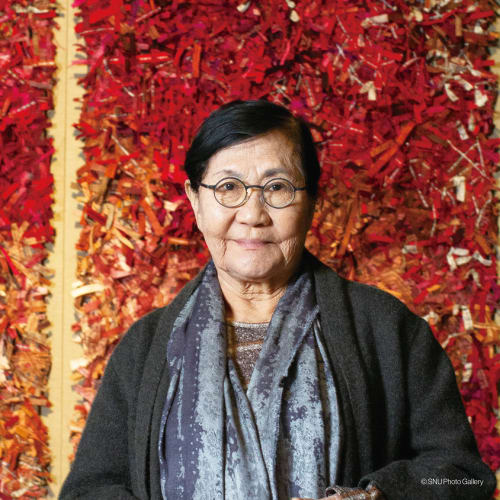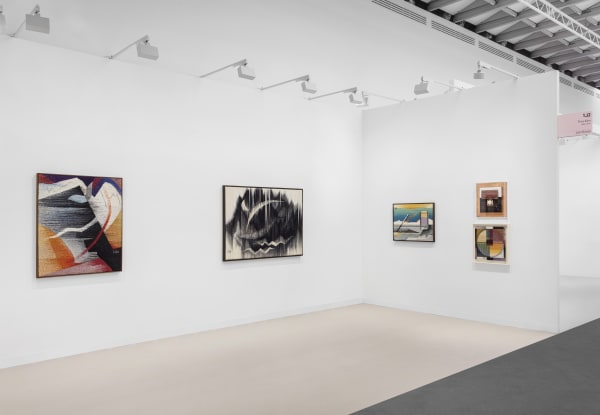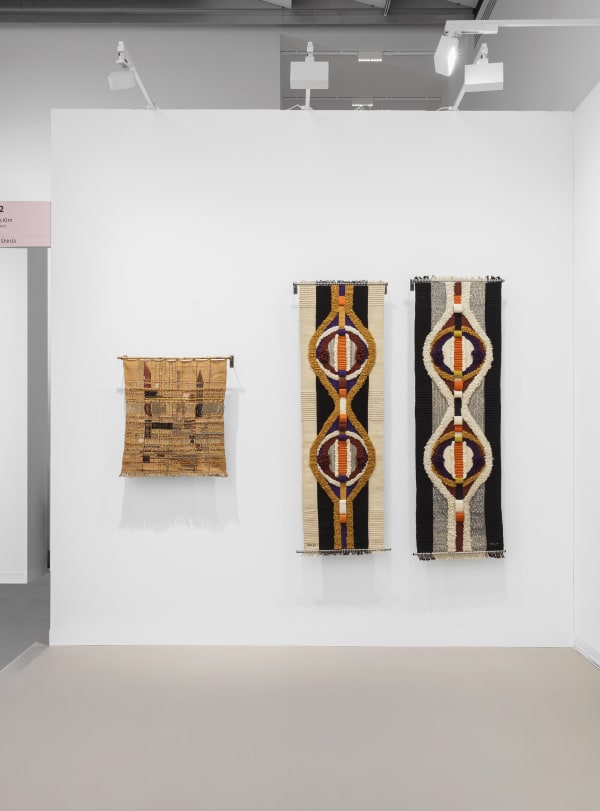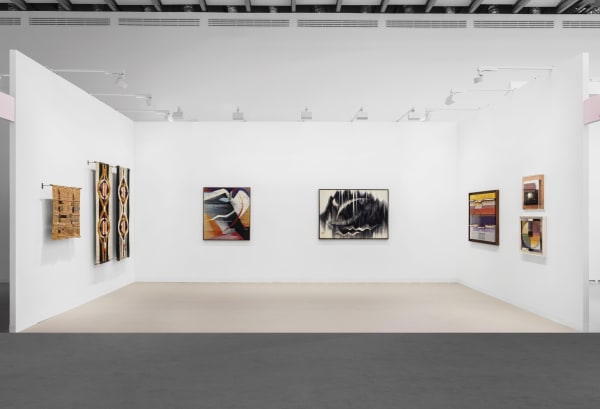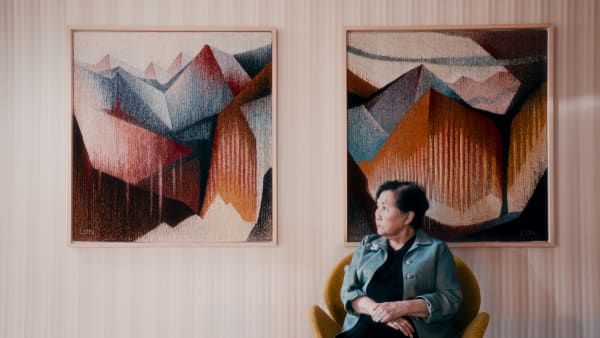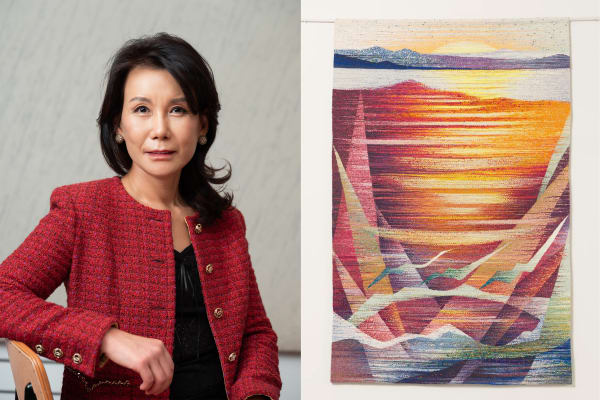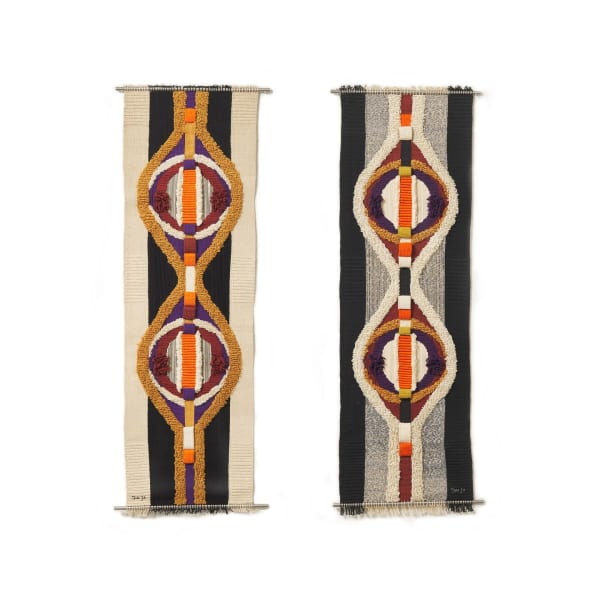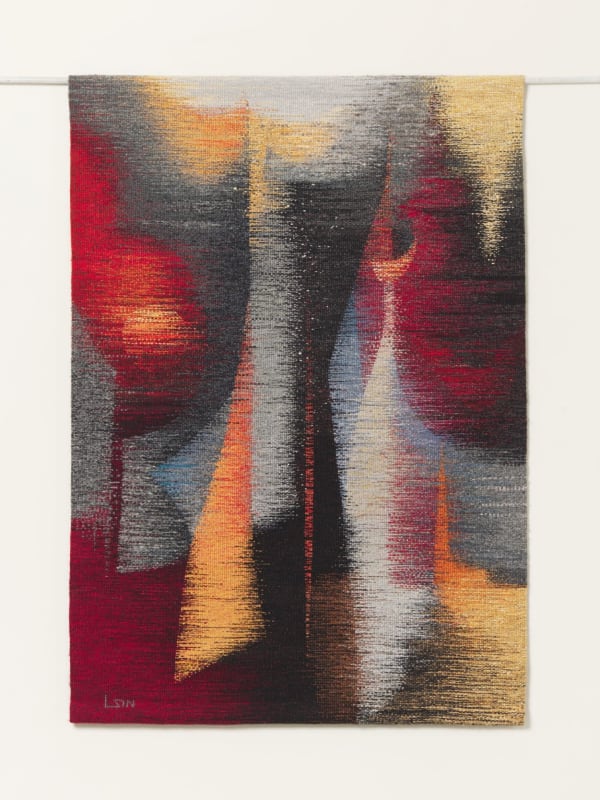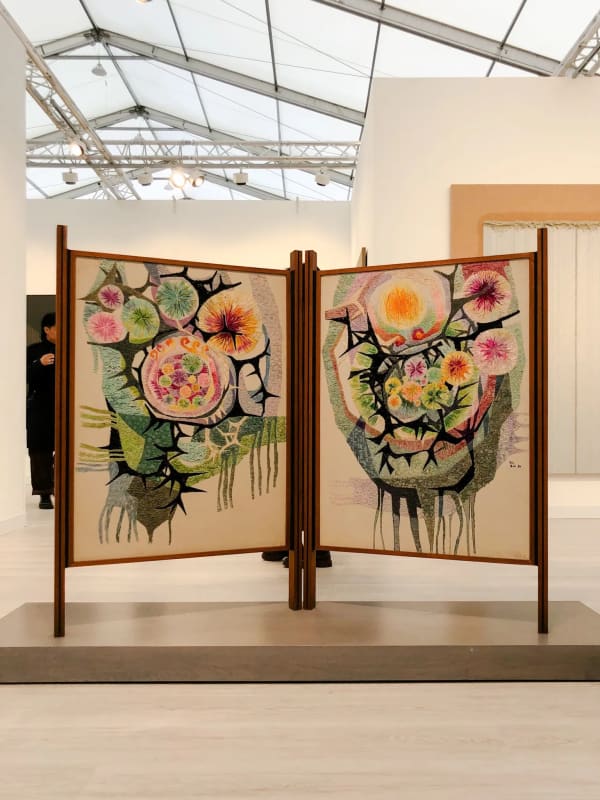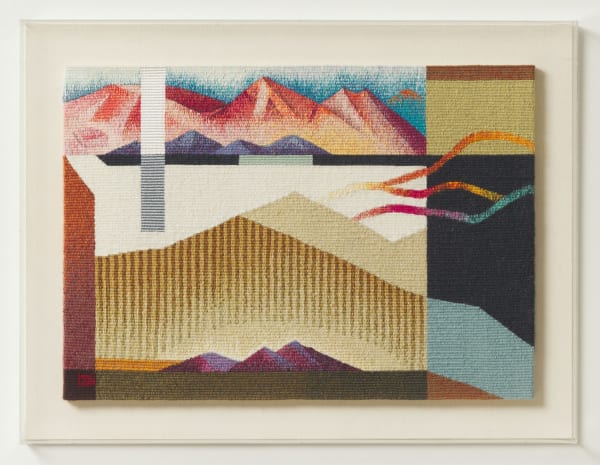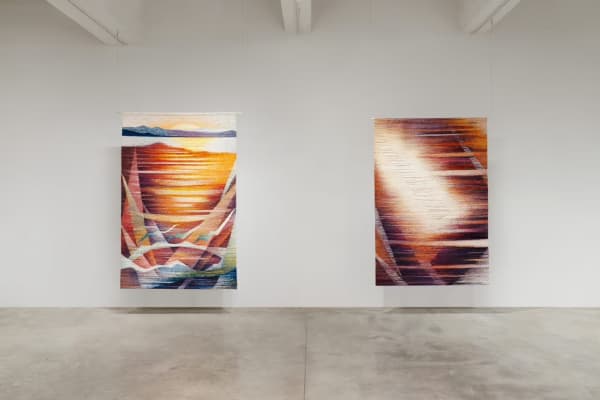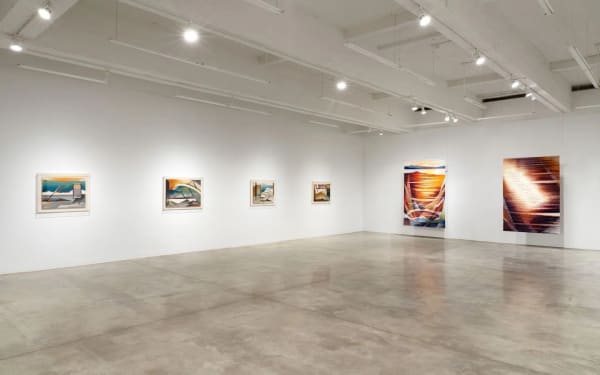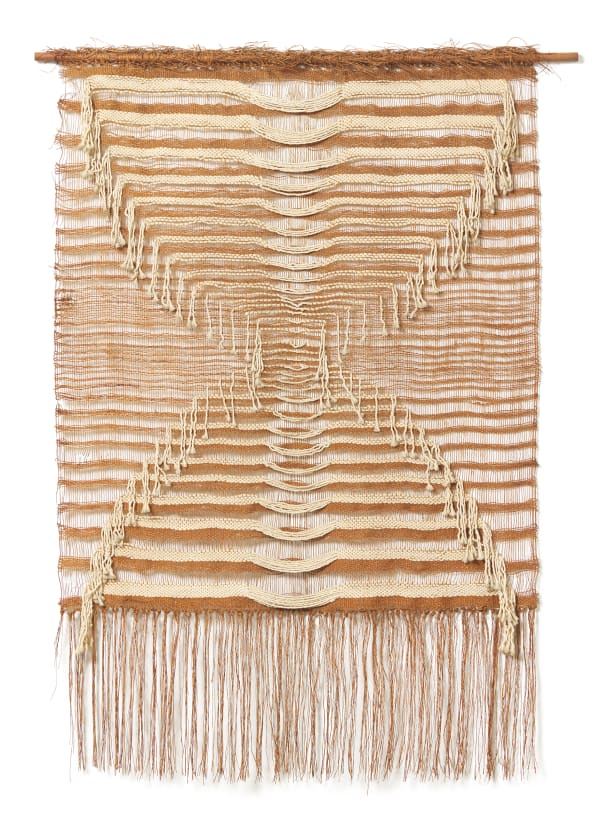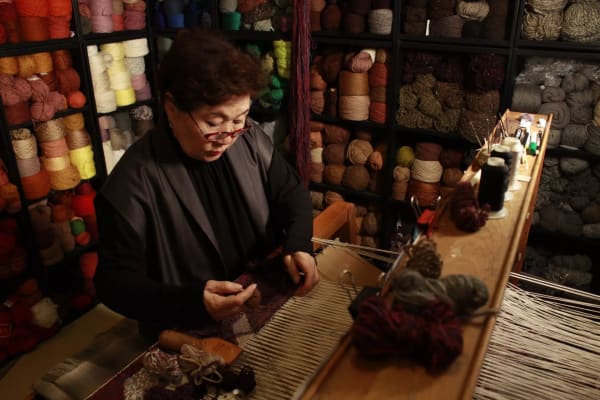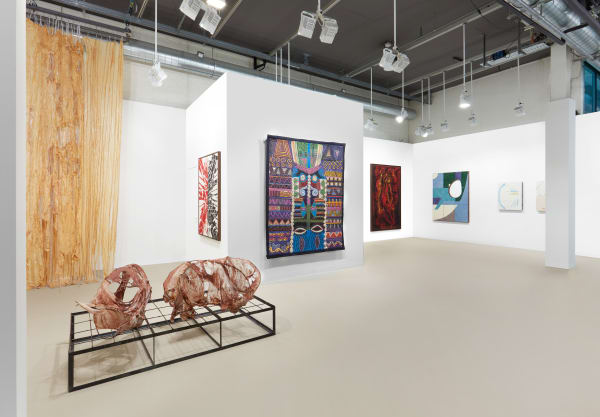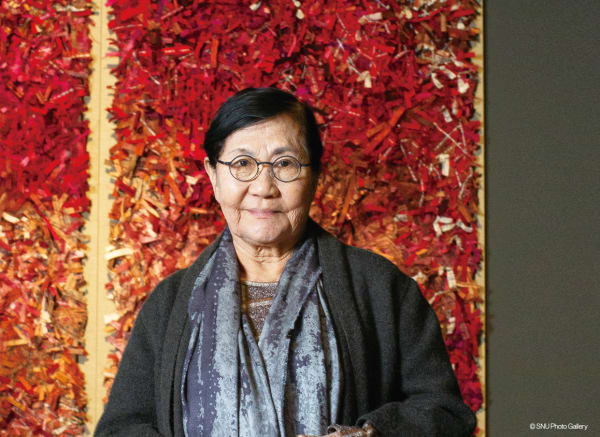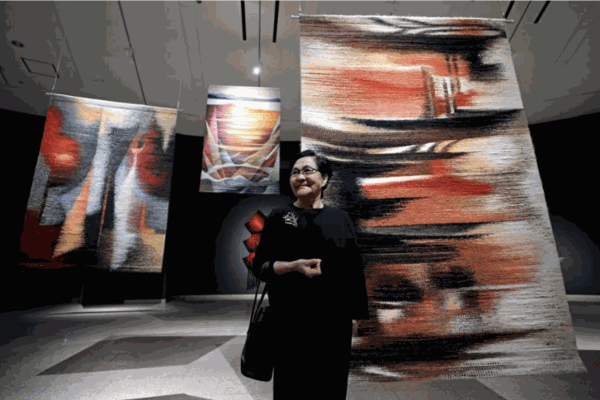Lee ShinJa is a pioneering first-generation Korean fiber artist and educator. During the 1950s and ’60s, when working with thread and fabric was considered domestic labor, Lee broke new ground in the evolution of Korean craft. Against the conventions of traditional craft, she experimented with modern formal techniques, driving innovations in embroidery, dyeing, weaving, and tapestry to expand the breadth and depth of the genre, which at the time was still unestablished.
Lee began her formal education in craft at Seoul National University in 1950, the year the Korean War broke out, and continued her studies at Busan Wartime Nations University. After graduating with her BFA in 1955, she presented her work in the National Art Exhibition of the Republic of Korea (National Exhibition), marking her debut in the Korean art scene and drawing the attention of the art community. At a time when figuration and traditional embroidery were seen as the preeminent styles, her work boldly veered towards abstraction through the use of wax-resist dye and contemporary embroidery applications to break up shapes and emphasize textures.
In 1965, she experienced a significant turning point in her early career when the Press Center in Seoul presented her debut solo exhibition. The show featured bold collages made from everyday materials such as flour sacks, mosquito nets, aluminum foil, and magazines. Although some critics accused her of “ruining traditional Korean embroidery,” she continued her innovative approach to create works like Portrait of My Daughter (1962), which is made with cotton and wool threads and oil pastels, and Image of City (1961), for which she unraveled portions of a woven cloth to braid and coil new fibers onto the loosened threads.
In the 1970s, Lee fully embraced tapestry techniques. Due to limitations in sourcing materials at the time, she cleverly repurposed fibers from wool sweaters and thread from bedding. When she was exposed to the works of international fiber artists at the 1970 Osaka World Expo in Japan, and later the 1983 Lausanne International Tapestry Biennial in Switzerland, she found the confidence to expand her practice into unique sculptural forms and installations. In the 1972 National Exhibition, she presented Wall Hanging (1971), which is considered Korea’s first-ever exhibited tapestry work. It led to the reclassification of the National Exhibition category “dyeing crafts” to “dyeing and weaving crafts.”
In addition to experimenting with new methods, even pursuing graduate training and earning her MFA in Fabric Design from Hongik University in 1974, Lee created abstract compositions by harmoniously balancing geometric motifs with lyrical colors. Notably, the abstract shapes in Conversation between Circles (1970s) and Sun and Moon I (1973) represent forms and elements found in nature. Meanwhile, Resurrection (1977) is composed in a structured manner and speaks to Lee’s affect during the declining health of her husband, artist Jang Woon-Sang (1926–82) who was known for pioneering modern Korean painting.
In the 1980s, Lee expanded her practice by integrating qualities of other media, such as painting and sculpture. Using materials like twine, paper, twigs, wires, and cables, she expanded her textile works to large-scale sculptural installations. Her pieces from this period—such as Memory (1985), Prayer I (1985), Echo (1985), and Retrospection of Autumn (1987)—are particularly notable for their intense contrast of red and black and their grand verticality. They convey not only Lee’s loss and despair following the death of her lifelong partner, but also a reverence for life and her will to live.
Regarding her series “Spirit of Mountain” from the 1990s, Lee remarked, “The seascape I saw off the coast of Uljin as a child and the spiritual energy brimming in the mountains I climbed while holding my father’s hand were saturated with everything, from the sound of waves to light, memories, love, and parting.” In these and other works, the artist sought to capture the intrinsic order of nature and her longing for the landscape of her hometown. The metal frames in her later works serve as windows, offering abstract glimpses into nature.
Lee’s work as an artist and educator transcends individual artistic achievement, leaving a unique legacy in the history of Korean fiber art and propelling the elevation of craft into fine art. As a founding member of the Korean Fiber Artists Association, she led the first edition of the Korean Fiber Art Biennale in 1984, and she served as the association’s president in 1986, steering the renaissance of Korean fiber art. From 1965 to 1997, she served as a professor at Duksung Women’s University, where she broke away from the traditional apprenticeship model in favor of a craft curriculum based on creativity, a shift that significantly influenced pedagogical practice. From 1997 to 2012, she operated Gallery Wooduk, an exhibition space supporting younger artists. She has been an active member of the Korean National Academy of Arts since 1997, and, in 1999, the Korean government awarded her the Silver Crown Order of Cultural Merit for her contributions to national cultural development.
Lee’s oeuvre has been exhibited widely in major solo exhibitions across Korea and abroad at galleries and institutions such as Press Center (1965), Gallery Hyundai (1983), Seoul Arts Center’s Hangaram Art Museum (1993), the Republic of Korea’s National Academy of Arts (2003) and more. In 2023, the National Museum of Modern and Contemporary Art (MMCA) in Gwacheon, Korea, presented her retrospective “Threadscapes,” which shed new light on the world of a pioneer who opened up the possibilities of fiber art. She has also participated in a number of group exhibitions including ones at MMCA Deoksugung (1986), Ho-Am Art Museum (1988), and Jakarta Textile Museum (2000), and biennials like the 5th Lausanne-Beijing International Fiber Art Biennale at Tsinghua University Academy of Arts and Design (2008). Lee’s works are housed in the collections of major institutions such as the National Museum of Korea, the National Museum of Modern and Contemporary Art, the Seoul Museum of Art, the Seoul Museum of Craft Art, Sookmyung Women’s University, Duksung Women’s University, and elsewhere.
-

Lee ShinJa: Drawing with Thread
BAMPFA 6 Aug 2025 - 1 Feb 2026The University of California, Berkeley Art Museum and Pacific Film Archive (BAMPFA) presents Lee ShinJa: Drawing with Thread , the first North American survey on the work of the historically...Learn More -

Lee ShinJa
Weaving the Dawn 22 Aug - 28 Sep 2024Tina Kim Gallery is pleased to announce “Weaving the Dawn,” the gallery’s first solo exhibition dedicated to Lee ShinJa—a pioneering artist who is remembered in Korean art history for introducing...Learn More -

Lee ShinJa: Threadscapes
MMCA Korea Gwacheon 22 Sep 2023 - 18 Feb 2024Lee ShinJa (b. 1930) is a prominent figure in the realm of Korean contemporary crafts and a pioneer of the first generation of fiber artists who devoted her life to...Learn More
-

Lee ShinJa: Drawing with Thread
Interviews August 18, 2025This video was produced in conjunction with Lee ShinJa: Drawing with Thread Berkeley Art Museum and Pacific Film Archive August 6, 2025 – February 1,...Learn More -

Lee ShinJa, Threadscapes|MMCA
Exhibition Walkthrough Video May 30, 2024Learn More -
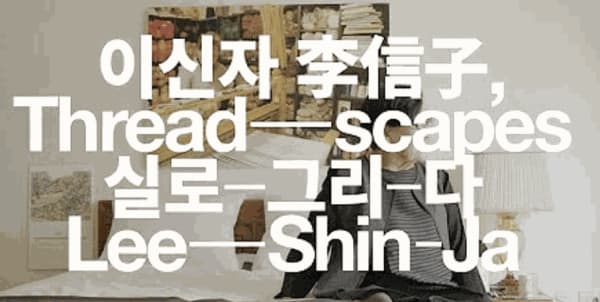
Lee ShinJa: Threadscapes | MMCA
Artist Interview May 29, 2024Learn More
-

Discover 10 Highlights from Art Basel Paris 2025
Galerie October 25, 2025Art Basel Paris now in its fourth edition, has firmly cemented the French capital’s newly renewed status as a global epicenter of art. Taking place...Learn More -

Paris Challenges London's Art Crown with the Launch of Art Basel Paris 2025 at The Grand Palais
Forbes October 24, 2025Hot on the heels of London’s whirlwind Frieze Week, the international art world has shifted its gaze to Paris, where Art Basel Paris 2025 opens...Learn More -

Best of Art Basel Paris
Le Quotidien de l'Art October 23, 2025Lee ShinJa's Spiritual Windows A regular at Art Basel and Art Basel Hong Kong, Tina Kim ventures into Paris this year, with a solo show...Learn More -

At 95, Lee ShinJa Weaves Artistic Exploration into Legacy
The New York Times October 21, 2025On a recent Wednesday afternoon, hushed “oohs” and “ahhs” could be heard coming from a lower-level gallery at the Berkeley Art Museum and Pacific Film...Learn More -

At Art Basel Paris, the Bold Premise Sector Reveals the Unseen
Art Basel September 15, 2025At the Grand Palais, the Premise sector 'is a space where definitions dissolve. We question the very nature of the artwork, the exhibition, and the...Learn More -

Fiber Art Takes Center Stage at Lee ShinJa's Beautiful Retrospective
Interior Design September 11, 2025Fiber art, particularly by nonagenarian women, continues to have a moment. An exhibition of works by 93-year-old Olga de Amaral runs until mid-October at the...Learn More -

Korean Textile Artist Lee ShinJa's First US Retrospective Debuts at Berkeley's BAMPFA
7x7 September 10, 2025This season, the Berkeley Art Museum and Pacific Film Archive (BAMPFA) is showcasing a remarkable retrospective of work by Lee ShinJa, one of South Korea’s...Learn More -

A South Korean Artist’s Experimental Fiber Works, on View in California
T Magazine August 6, 2025This week, the 94-year-old South Korean fiber artist Lee ShinJa receives her first North American museum retrospective at California’s Berkeley Art Museum and Pacific Film...Learn More -

These 5 Women-Led Galleries Are Championing Overlooked Women Artists
Artsy March 3, 2025The art world has long operated under a patriarchal gaze, often sidelining the contributions of women whose accolades, if recognized, often arrive decades late. The...Learn More -

Clara Kim's Top Picks from Frieze Viewing Room
Frieze February 13, 2025The MOCA chief curator's choices from Frieze Viewing Room include works by Hadi Falapishi, Alison Saar and Megumi Yuasa. Lee ShinJa, Conversation between Circles IV...Learn More -

Actually Good Word Art—and More Genre-Defying Decor at This Year’s FOG Design + Art Fair
dwell January 24, 2025The San Francisco Bay Area’s art and design community is tight-knit. The artists, designers, and architects living here all seem to know each other’s names....Learn More -

2024 Was the Year of the Art World's High Fiber Diet
Art in America December 12, 2024This year, the art world went on a high fiber diet. Abstract weavings, knotted sculptures, expressive basketry, shaggy wall hangings: all are coming out of...Learn More -

Five monumental works not to miss in Art Basel Miami Beach's Meridians sector
Art Basel November 29, 2024This year, Art Basel Miami Beach will celebrate five years of Meridians, the show’s sector dedicated to large-scale works that might not otherwise have a...Learn More -

The Best of Frieze London — 10 Curious, Captivating Installations With Unexpected Homeware Potential
Livingetc October 11, 2024Frieze London kicked off on Wednesday with a VIP welcome and is open to the public starting today. The 21st edition of one of the...Learn More -

Art Basel Miami Beach Shakes Up Meridians Sector
Ocula October 3, 2024Institutionally-minded' large-scale installations will take centre stage at this year's Art Basel Miami Beach. Led by director Bridget Finn, who was appointed last September, the...Learn More -

8 Must-See Solo Gallery Shows in September
Galerie September 3, 2024Rounding up the best gallery exhibitions across the United States each month, Galerie journeyed from New York to California to discover the top solo shows...Learn More -

Lee ShinJa’s “Weaving the Dawn” Exhibition Brings Seven Decades of Fiber Art to New York
stupidDOPE August 28, 2024Artist Lee ShinJa weaves together autobiography and abstract beauty in her solo exhibition, “Weaving the Dawn,” now on view at Tina Kim Gallery in New...Learn More -

'Weaving the Dawn' Spotlights Seven Decades of Lee ShinJa's Fiber Art
Hypebeast August 27, 2024Lee ShinJa’s tapestries begin and end at the crest of the Uljin mountains. Her work braids together autobiography and fractal abstractions into the shape of...Learn More -

6 New York Shows to See during Armory and into Autumn
Ocula August 27, 2024Anticipating New York 's Autumn art fair season this September, we have selected six must-see exhibitions. From Lee ShinJa's intricate tapestries at Tina Kim to...Learn More -

At 94, the Pioneering Lee ShinJa Weaves a New Tradition for Feminist Textile Art
Colossal August 22, 2024When artist Lee ShinJa was born in 1930 in Uljin, Korea, during a period of Japanese colonial rule, textile traditions were largely rooted in domestic...Learn More -

Lee ShinJa Weaves a New Dawn at Tina Kim Gallery in New York
Whitewall August 16, 2024On August 22 in New York, the groundbreaking Korean fiber artist Lee ShinJa will unveil her first solo presentation with Tina Kim Gallery , “Weaving...Learn More -

At 94, Trailblazing Fiber Artist Lee ShinJa Is Gaining Overdue Acclaim
Artsy August 8, 2024As a child, Lee ShinJa would often accompany her father to watch the sunrise in the serene landscapes of Uljin, South Korea, where towering mountains...Learn More -

Tina Kim Illuminates the 6 Best of Basel in June
Whitewall June 14, 2024The illustrious Tina Kim founded her namesake gallery in 2001 in New York, and ever since then has been a guiding light in the international...Learn More -

Now Representing: Lee ShinJa
June 5, 2024Tina Kim Gallery is delighted to announce its representation of Lee ShinJa, a pioneering first-generation Korean fiber artist. She will debut with the gallery at...Learn More -

Shapes of Life Accomplished with Weft and Warp
SNU People September 29, 2023I am curious about your childhood. Were you a child with manual dexterity? I was born in Uljin, North Gyeongsang Province, in 1930. Although I...Learn More -

Trailblazing nonagenarian artist honored for redefining Korean fiber art
The Korea Times September 29, 2023In the 1950s and 1960s, Lee Shin-ja stood out as something of an oddball in Korea’s fiber art scene. Fresh out of college with a...Learn More
